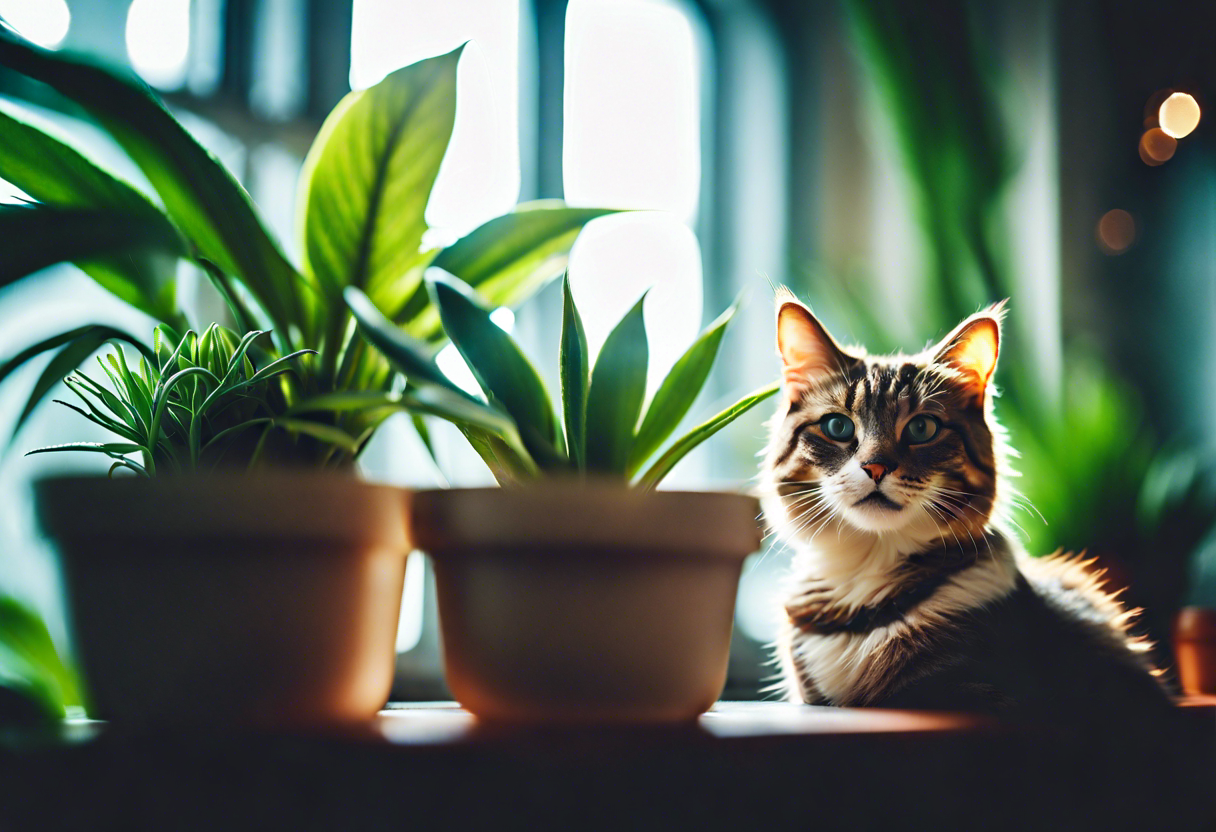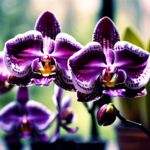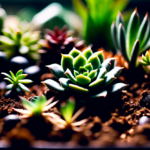Top 10 Indoor Plants Safe for Cats
When it comes to creating a safe and stimulating environment for your feline friend, incorporating indoor plants can be a great way to enhance their space. However, it’s important to choose plants that are not only visually appealing but also safe for cats. In this article, we will explore the top 10 indoor plants that are safe for your beloved furry companions.
-
Spider Plant (Chlorophytum comosum) – Spider plants are not only known for their air-purifying properties but are also non-toxic to cats. These plants have long, arching leaves that add a touch of elegance to any room, making them an ideal choice for households with cats.
-
African Violet (Saintpaulia) – With their vibrant and velvety leaves, African violets are a popular choice among indoor gardeners. These plants are not only aesthetically pleasing but also safe for cats. Be sure to keep them in well-lit areas, and your cat will be able to enjoy their beauty without any worry.
-
Areca Palm (Dypsis lutescens) – If you’re looking to add a touch of tropical flair to your indoor space, the Areca palm is an excellent choice. This plant boasts feathery, arching fronds and is completely safe for cats, making it a wonderful addition to any cat-friendly home.
-
Money Plant (Epipremnum aureum) – Also known as Devil’s Ivy, the Money Plant is a popular choice for indoor gardening enthusiasts. Not only is it low maintenance, but it is also non-toxic to cats, making it an excellent addition to your feline-friendly indoor garden.
-
Calathea (Calathea spp.) – Calatheas are known for their strikingly patterned leaves, making them a visually appealing choice for indoor plants. Fortunately, they are also safe for cats, allowing you to enjoy both the beauty of the plant and the companionship of your feline friend.
-
Phalaenopsis Orchid (Phalaenopsis spp.) – Orchids are renowned for their elegance and beauty. The Phalaenopsis orchid is not only a stunning addition to any indoor space but is also safe for cats. Keep in mind that while the plant itself is non-toxic, any fertilizers or pest control products should be kept away from your furry friend.
-
Boston Fern (Nephrolepis exaltata) – Boston ferns are a popular choice among indoor plant enthusiasts due to their feathery fronds. The good news is that they are also safe for cats, adding a touch of greenery to your feline-friendly space.
-
Polka Dot Plant (Hypoestes phyllostachya) – With its eye-catching pink or white spotted leaves, the Polka Dot plant is sure to be a conversation starter. More importantly, it is non-toxic to cats, giving you peace of mind while enjoying the visual appeal it brings to your indoor garden.
-
Peperomia (Peperomia spp.) – Peperomias are a diverse group of plants with various leaf shapes and colors. These low-maintenance plants not only add beauty to your indoor space but are also safe for your feline companions.
-
Christmas Cactus (Schlumbergera spp.) – The Christmas cactus is a popular choice for holiday decorations, thanks to its vibrant blooms. Luckily, it is also safe for cats, allowing you to enjoy the festive atmosphere without worrying about your furry friend.
Now that you’re aware of the top 10 indoor plants that are safe for cats, you can create a harmonious and visually appealing indoor garden that both you and your feline companion can enjoy. Remember to place these plants in areas that are accessible to your cat, but still within a safe distance to avoid any accidental nibbling. With the right plants, you can enhance your home environment while keeping your cat’s safety a top priority.
Benefits of Having Indoor Plants for Cats
The Benefits of Indoor Plants for Cats
Indoor plants can do more than just add beauty to your home; they can also provide numerous benefits for your furry feline friends. Not only do indoor plants help to improve the air quality in your home, but they can also offer entertainment and enrichment for your cats. Here are some of the key benefits of having indoor plants for cats.
1. Improved Air Quality
One of the significant advantages of indoor plants is their ability to purify the air. Plants absorb carbon dioxide and release oxygen through a process called photosynthesis. This helps to freshen the air and remove toxins, such as volatile organic compounds (VOCs) and allergens. By having indoor plants in your home, you can create a healthier breathing environment for both yourself and your cats.
2. Natural Stress Relief
Indoor plants can have a calming effect on cats. The presence of plants indoors can provide a sense of peace and tranquility, helping to reduce stress levels in your feline companions. Spending time near indoor plants can be particularly beneficial for cats that may be anxious or nervous.
3. Entertainment and Stimulation
Indoor plants can offer a source of entertainment and mental stimulation for cats. Cats are naturally curious animals, and they love to explore their surroundings. Having plants indoors gives them the opportunity to investigate and interact with something new. Your cats may enjoy batting at leaves, sniffing flowers, or simply observing the movements of the plants.
4. Natural Scratching Alternative
Many indoor plants have textured leaves that can serve as a natural scratching alternative for cats. Having plants with leaves that cats can rub against or scratch can help divert their attention away from furniture, curtains, or other household items that may suffer from their scratching habits. Just be sure to choose plants with non-toxic foliage to ensure the safety of your cats.
5. Enrichment and Exercise
Indoor plants can provide cats with opportunities for physical exercise and mental enrichment. Cats can hide, chase, and play around plants, which helps to keep them active and engaged. You can enhance the experience by placing toys or treats near the plants, encouraging your cats to explore and interact with their environment.
Incorporating indoor plants into your home can be highly beneficial for your cats. Not only do they contribute to cleaner air and a more calming environment, but they also provide entertainment, natural scratching options, and opportunities for exercise and mental stimulation. Just make sure to choose plants that are safe for cats and place them in areas where your cats can access them without any hazards. Your feline friends will surely enjoy the many benefits that indoor plants bring to their lives.
How to Choose the Right Indoor Plants for Your Cat
Choosing the right indoor plants for your cat is crucial to ensure the safety and well-being of your furry friend. While many indoor plants can enhance the aesthetics of your home, not all plants are safe for cats. Some plants can be toxic and pose a threat to their health if ingested. To help you create a safe and cat-friendly environment, here are some tips on how to choose the right indoor plants for your cat.
Consider Non-Toxic Plants
When selecting indoor plants, it’s important to opt for varieties that are non-toxic to cats. There are plenty of beautiful plants available that won’t harm your feline companion. Spider plants, Boston ferns, and African violets are just a few examples of non-toxic plants that you can confidently bring into your home. These plants not only add a touch of greenery to your indoor space but also provide a safe environment for your cat to explore.
Avoid Toxic Plants
To ensure the safety of your cat, it’s essential to be aware of common indoor plants that are toxic to them. Some popular houseplants, such as lilies, pothos, and peace lilies, should be avoided as they can cause severe health issues if ingested. Symptoms of plant toxicity in cats can include vomiting, diarrhea, difficulty breathing, and even organ failure. Therefore, it’s crucial to thoroughly research the potential toxicity of any plants you plan to introduce into your home.
Take Into Account Your Cat’s Behavior
Each cat has unique behaviors and preferences. Some cats are more curious and may be prone to exploring and nibbling on plants, while others may show little interest in them. Understanding your cat’s behavior can help you make informed decisions when choosing indoor plants. If you have a particularly curious cat, it’s best to opt for plants that are less enticing or place them in areas that are inaccessible. This way, you can minimize the risk of your cat ingesting any potentially harmful plants.
Consider Plant Placement
Proper plant placement is vital when creating a cat-friendly indoor garden. Consider elevating your plants by placing them on high shelves, hanging them from the ceiling, or using plant stands. These placements can deter your cat from reaching the plants and prevent accidental ingestion. Additionally, ensure that any trailing vines or leaves are trimmed to prevent your cat from chewing on them.
Provide Alternative Options
Cats often chew on plants out of curiosity or to satisfy their natural instincts. To redirect their attention away from your indoor plants, provide alternative options such as cat grass or catnip. These alternatives can provide mental stimulation and satisfy your cat’s need to chew. Moreover, you can consider introducing interactive toys or scratching posts to keep them engaged and entertained.
When choosing indoor plants for your cat, prioritize their safety by selecting non-toxic varieties. Take into account your cat’s behavior and ensure proper plant placement to prevent any accidental ingestion. By creating a cat-friendly indoor garden, you can enhance the beauty of your home while providing a safe space for your feline companion. Remember, a little planning and consideration go a long way in creating a harmonious living environment for both you and your furry friend.
Top 10 Indoor Plants Safe for Cats
Common Indoor Plants That Are Toxic to Cats
When it comes to creating a safe and cat-friendly indoor environment, it’s essential to be aware of the potential dangers that certain household plants can pose to your feline companion. While plants can help improve air quality and add a touch of nature to your home, some varieties are poisonous to cats if ingested. To ensure the well-being of your furry friend, it’s crucial to familiarize yourself with the common indoor plants that are toxic to cats.
One common indoor plant that is hazardous to cats is the lily. While beautiful and fragrant, lilies, particularly those belonging to the Lilium and Hemerocallis species, can cause severe kidney damage in cats even when consumed in small amounts. It’s important to note that all parts of the lily plant, including the leaves, flowers, and even the pollen, are toxic to cats.
Another plant to be wary of is the popular peace lily. Although it’s a visually appealing choice for indoor gardens, peace lilies contain calcium oxalate crystals that can cause mouth irritation, excessive drooling, and difficulty swallowing if chewed or ingested by cats. Similarly, Sago palms, a common houseplant, can be highly toxic to cats when any part of the plant is consumed. Ingesting even small amounts of the Sago palm can result in severe symptoms such as diarrhea, vomiting, seizures, and even liver failure.
Dieffenbachia, commonly known as dumb cane, is another household plant that poses a risk to cats. Its leaves contain calcium oxalate crystals, which can cause oral irritation, excessive drooling, and difficulty breathing if chewed or ingested. Similarly, the popular snake plant, also known as mother-in-law’s tongue, contains saponins, which can cause nausea, vomiting, and diarrhea in cats.
Other plants that should be avoided in homes with cats include the pothos plant, philodendron, aloe vera, and the spider plant. These plants contain substances that can lead to gastrointestinal upset, oral irritation, and even more severe symptoms in some cases.
To create a cat-friendly indoor garden, it’s important to choose plants that are safe for your furry friend. Here are some examples of indoor plants that are nontoxic to cats:
- Boston fern
- Areca palm
- Spider plant (chlorophytum)
- Calathea
- Parlor palm
- Polka dot plant (hypoestes)
- Prayer plant (maranta)
- Burro’s tail (sedum morganianum)
- Money tree (pachira aquatica)
- Bamboo palm
These plants can add greenery to your home while providing a safe and stimulating environment for your cat. Remember to always research a plant’s toxicity before introducing it to your indoor space, and if you suspect your cat has ingested a toxic plant, contact your veterinarian immediately. By being aware of the common indoor plants that are toxic to cats and carefully selecting safe alternatives, you can create a harmonious and pet-friendly home.
Creating a Cat-Friendly Indoor Garden
Creating a cat-friendly indoor garden can be a wonderful way to enhance your living space while ensuring the safety and well-being of your feline companions. Indoor plants have numerous benefits for both humans and cats alike, ranging from improved air quality to stress reduction. By carefully selecting and arranging plants, you can create a vibrant and safe environment that your cats will love.
When it comes to choosing plants for your cat-friendly indoor garden, it’s important to consider their toxicity levels. Many common indoor plants can be toxic to cats if ingested, causing symptoms such as gastrointestinal upset, drooling, vomiting, and even organ damage. Therefore, it is crucial to choose plants that are safe and non-toxic for your furry friends.
One of the top choices for cat-safe indoor plants is the spider plant (Chlorophytum comosum). Not only is this plant non-toxic to cats, but its long, arching leaves provide a playful and irresistible temptation for our curious feline friends. Another excellent option is the Boston fern (Nephrolepis exaltata), which not only adds lushness to your indoor garden but is also safe for cats.
If you’re looking for plants with colorful blooms, consider the African violet (Saintpaulia). This beautiful flowering plant is not only non-toxic to cats but comes in a variety of shades, adding a pop of color to your indoor garden. Additionally, the spider plant, Boston fern, and African violet are all relatively low-maintenance plants, making them perfect choices for beginners or those with a busy lifestyle.
Another cat-friendly option is the catnip plant (Nepeta cataria). Catnip provides sensory stimulation for cats and can help alleviate stress and anxiety. Placing catnip plants in your indoor garden can provide hours of entertainment for your cats. Just be prepared for some rolling, rubbing, and playful antics!
To ensure the safety of your cats, it’s important to arrange your indoor garden in a way that prevents them from accessing any toxic plants. Place toxic plants in areas that are inaccessible to your cats, such as high shelves or hanging baskets. It’s also a good idea to monitor your cats’ behavior around plants and discourage any nibbling or chewing.
Creating a cat-friendly indoor garden can be a rewarding and enjoyable experience. By selecting non-toxic plants and arranging them in a safe and accessible manner, you can provide your cats with a stimulating environment while ensuring their well-being. So go ahead and incorporate these cat-safe indoor plants into your home, and watch your feline companions thrive in their green oasis.
Conclusion
Indoor plants can be a wonderful addition to your home while also ensuring the safety and well-being of your feline friend. By choosing the right plants, such as spider plants, Boston ferns, or catnip, you can provide a stimulating and enriching environment for your cat without putting them in harm’s way. These plants not only serve as natural air purifiers but also offer numerous benefits for your furry companions.
Having indoor plants can contribute to the overall health and well-being of your cat. The presence of plants in your home can encourage exercise and play, providing entertainment and mental stimulation for your feline friend. Cats love to explore and hide among plants, engaging their natural instincts and promoting physical activity. Additionally, indoor plants can help reduce stress and anxiety, creating a calming and peaceful environment for both you and your pet.
Choosing the right indoor plants for your cat is crucial to ensure their safety. It is recommended to research each plant thoroughly before bringing it into your home. Avoid toxic varieties such as lilies, peace lilies, or pothos, as these can cause serious health issues if ingested. Opt for non-toxic plants that are safe for cats, such as the aforementioned spider plants or Boston ferns. It is always better to be cautious and prevent any potential hazards.
While there are numerous indoor plants safe for cats, it is essential to be aware of the common indoor plants that can be toxic to them. Plants like lilies, azaleas, and dieffenbachia can cause severe reactions, such as vomiting, diarrhea, or even organ failure. It is vital to keep these toxic plants out of your home or prevent your cat from accessing them. If you suspect your cat has ingested a toxic plant, seek immediate veterinary attention.
Creating a cat-friendly indoor garden involves more than just selecting safe plants. It is important to ensure that the plants are easily accessible for your cat to explore and interact with. Consider placing them in window sills, hanging baskets, or providing climbing structures for your cat to enjoy. Be mindful of any potential hazards, such as loose soil or plants that can easily be knocked over. Regularly check the plants for any signs of damage, as some cats may be prone to chewing or scratching them.
Indoor plants can enhance both your home’s aesthetics and your cat’s well-being. By selecting non-toxic plants and creating a cat-friendly environment, you can provide a safe and enriching space for your feline companion. Remember to research each plant thoroughly, avoiding any toxic species that could pose a risk to your cat’s health. With careful consideration and planning, indoor plants and cats can coexist harmoniously, bringing joy and beauty to your home.


